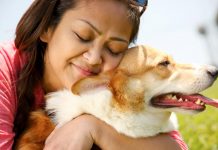Lovebirds are small parrots that measure five or six inches long and weigh about two ounces. They have rounded heads and their beaks are relatively large. There are nine different species of lovebirds, all of which have green body feathers with varying colors on their heads and necks. Some have characteristic light to bright orange, yellow, gray, black, or red on their heads and necks.
Lovebirds originate from the continent of Africa, including Madagascar. Some of the African regions where they are located include Tanzania, Malawi, Zambia, Botswana, South Africa, Namibia, and Ethiopia. Lovebirds are popular pet birds due to their ease of maintenance, their playful and energetic nature, and their beautiful colors. When housed alone, they will seek attention from their humans. They often form a deep connection to another lovebird and can pair bond with their mate for life. They are vocal chatters, but their chirping is not able to mimic talking like some other parrots.
The life expectancy of lovebirds in captivity averages from 10-20 years. Lovebirds in the wild tend to have shorter life spans of 5-10 years. The oldest recorded lovebird in captivity lived to be 34 years old.
Lovebird Housing
Lovebirds are social birds that live in flocks and forage together. The ideal temperature range for lovebirds is 70-80 degrees Fahrenheit, though they can tolerate temperatures from 60-90 degrees. They should be housed away from direct sunlight, avoiding drafts but be a well-ventilated area that has good exposure to light.
The size requirement for an enclosure is a minimum of 18”x18”x18” for a single lovebird or 32”x20”x20” for each pair of lovebirds. There should be a maximum of ¾ inches between bars. Be sure to include food and water bowls, a variety of perch options, and an area for a water bath.
Great cages for lovebirds include:
Lovebirds love to chew and forage for food items. In captivity, they should be provided with foraging toys and puzzles to keep them busy and mentally stimulated. These toys should be rotated weekly and replaced monthly. Lovebirds should also be allowed daily exposure to natural sunlight, or a UV lamp may be provided as an alternative source of ultraviolet light. Recommendations for lovebird enrichment include:
What to Feed a Lovebird
A pelleted diet is recommended for lovebirds since every bite provides balanced nutrition. There are many brands available that have various sizes, colors, and flavors. If a lovebird refuses to eat a pelleted diet, a formulated seed mix (seeds stuck together with pellets) can be offered to help ensure they are receiving needed vitamins and minerals. Pellets should comprise 70- 80% of their total diet. The other 20-30% can be fresh foods such as various vegetables and fruits. Fresh produce contains much more nutrition than dried produce.
Recommended food products for lovebirds include:
Seeds and nuts are high in fat and should be reserved as occasional treats. Some healthy table food items that may be offered as an occasional treat include scrambled or hard-boiled eggs, rice, pasta, whole wheat bread, and no-salt crackers. Treats should be limited to 10% or less of the total diet each week.
Lovebirds should be offered a new portion of food daily. Any remaining food from the previous day should be discarded. Fresh produce should be discarded within several hours to avoid contamination and spoilage.
Lovebirds are beautiful colorful birds that are lively and fun to watch. They are family friendly and love to play and socialize with other birds and humans. They will chirp to communicate and readily interact with people and other birds. The inquisitive and animated nature of the lovebird will delight and entertain humans of all ages.































